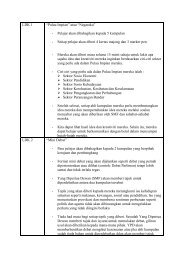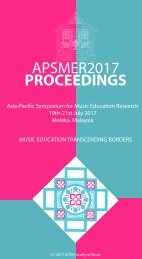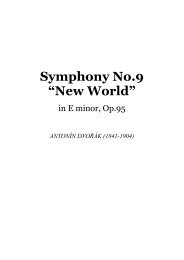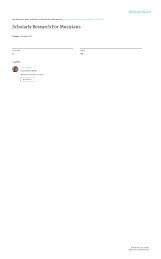APSMER2017 PROCEEDINGS
Create successful ePaper yourself
Turn your PDF publications into a flip-book with our unique Google optimized e-Paper software.
Proceedings of the 11th Asia-Pacific Symposium for Music Education Research<br />
(APSMER 2017) 19th to 21st July 2017, Melaka MALAYSIA<br />
2015). The teachers inspired the players’ imagination, and accepted,<br />
combined and expanded the unexpected ideas. They consolidated those ideas<br />
as a coherent work by interaction with the players.<br />
I don’t think this observation is able to be generalized. Because there<br />
were only a few participants. The title and all of the musical marks were<br />
withheld from the teachers and the players in this experimental situation.<br />
However, it corresponded with my former investigation that unexperienced<br />
teachers were inclined to focus on making “an accurate performance.” It<br />
included collections of pitches and timings of each note. While experienced<br />
teachers inspired players spontaneous musical expression based on the<br />
players’ understanding of musical construction (Suga 2009). Further research<br />
is needed to develop curriculums for music teacher training to cultivate<br />
future music teachers’ improvisational ability to improve students’ musical<br />
expression by interaction with them.<br />
References<br />
Abramo J.M., Reynolds A. (2014). "Pedagogical Creativity" as a Framework<br />
for Music Teacher Education. Journal of Music Teacher Education, 25,<br />
37-51.<br />
Ebie B.D. (2004). The effects of verbal, vocally modeled, kinesthetic, and<br />
audio-visual treatment conditions on male and female middle-school<br />
vocal music students’ abilities to expressively sing melodies.<br />
Psychology of Music, 32(4), 405-417.<br />
Fournier J.E. (2011). Productive improvisation and collective creativity:<br />
Lessons from the dance studio. In K. Sawyer (Ed.), Structure and<br />
improvisation in creative teaching (pp.184-206). New York, NY:<br />
Cambridge University Press.<br />
Holzman L. (2010). Without creating ZPDs there is no creativity. In M.<br />
Cathrene Connery, V. John-Steiner & A. Marjanovic-Shane (Eds.),<br />
Vygotsky and creativity: A cultural-historical approach to play, meaning<br />
making, and the arts (pp.27-39). New York, NY: Peter Lang.<br />
Karlsson J. & Juslin P. (2008). Musical expression: an observational study of<br />
instrumental teaching. Psychology of Music 36(3), 309-334.<br />
Kanai T. & Kusumi T. (2012). Practical Intelligence of Professional<br />
43








